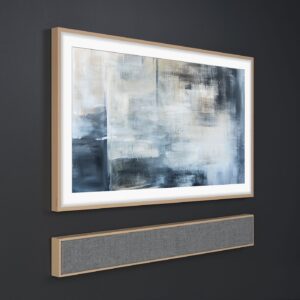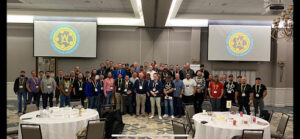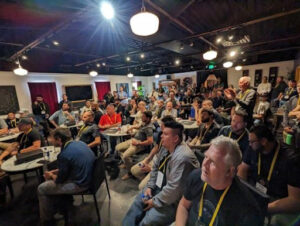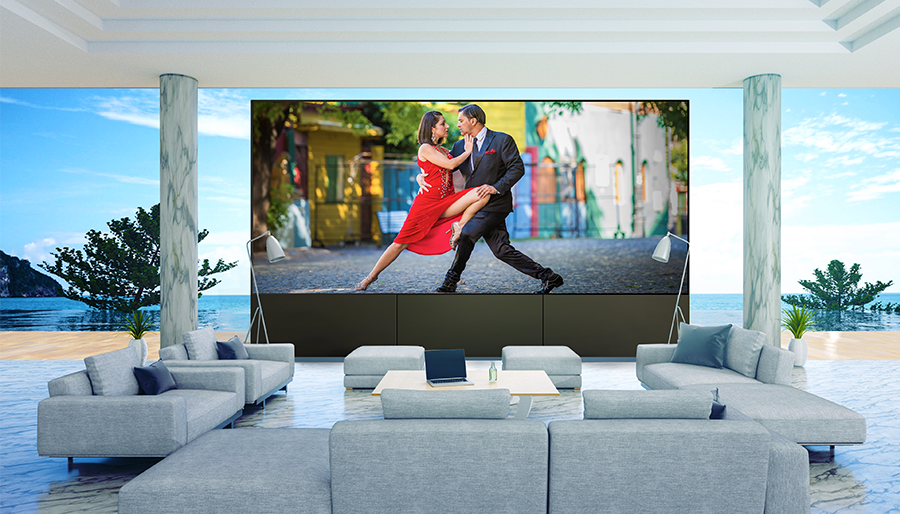by KMB Communications | Jul 24, 2023 | Leon Speakers, News, Trade Show news


 Designed for larger screens and easy integration, two new highly anticipated powered and passive FrameBars add on-board amplification and increased performance to Leon’s designer Framebar series.
Designed for larger screens and easy integration, two new highly anticipated powered and passive FrameBars add on-board amplification and increased performance to Leon’s designer Framebar series.
[Ann Arbor, MI] – July 24, 2023 – Leon is thrilled to announce the release of two new soundbars to its acclaimed FrameBar series. The new Powered FrameBar and FrameBar 44UX feature the original FrameBar’s seamless integration with Samsung’s The Frame TV—now with the powerful performance and high-fidelity audio of Leon’s Horizon 44UX soundbar.
 Built to match the exact width and finish options of Samsung’s The Frame TV, all FrameBar products provide a unified, modern look to complement The Frame TV’s artistic style. Meticulously engineered and handcrafted with 4” ultra-thin, audiophile-grade woofers and 1” silk-dome tweeters, the Powered Framebar and FrameBar 44UX each boast enhanced sound capabilities without sacrificing the clean, elegant look of the original FrameBar.
Built to match the exact width and finish options of Samsung’s The Frame TV, all FrameBar products provide a unified, modern look to complement The Frame TV’s artistic style. Meticulously engineered and handcrafted with 4” ultra-thin, audiophile-grade woofers and 1” silk-dome tweeters, the Powered Framebar and FrameBar 44UX each boast enhanced sound capabilities without sacrificing the clean, elegant look of the original FrameBar.
The Powered FrameBar offers both the refinement and flexibility of Leon’s OTO MCA 200 amplifier, enabling effortless installation and minimal wiring in an all-in-one, plug-and-play solution—delivering the ultimate audio experience for Samsung’s Frame TV.
Key Features and Benefits of Leon’s Powered FrameBar and FrameBar 44UX Soundbars:
- Superior Sound Quality: Equipped with 4″ ultra-thin woofers and 1″ silk-dome tweeters, the Powered FrameBar and FrameBar 44UX deliver exceptional audio performance, immersing users in rich, detailed soundscapes.
- Width and Finish Match: Each FrameBar perfectly matches the width and finish of any Samsung The Frame TV, ensuring a visually cohesive entertainment system that elevates the viewing experience.
- Power and Simplicity: With its 200-watt on-board amplifier, the Powered FrameBar offers easy integration and minimal wiring, simplifying the installation process.
“Our philosophy at Leon has always been about delivering superior design without compromising on sound,” says Leon founder and president Noah Kaplan. “The Powered FrameBar and FrameBar 44UX soundbars exemplify this philosophy, catering to discerning clients who seek exceptional design and an unrivaled listening experience.”
To explore the complete FrameBar series, including the full range of finishes and designer grille fabrics available, visit Leon’s website.
About Leon Speakers
Leon brings a creative approach to technology by designing and manufacturing customizable speakers and technology concealment solutions that enhance the sound and style of any space. For over 25 years, the company has been a leader in the conversation about merging design with technology, creating innovative products that serve both the Residential and Commercial markets. Learn more by visiting www.leonspeakers.com and by following @leonspeakers on social media.
Media Contacts
Press Contact: Katye (McGregor) Bennett
KMB Communications
(425) 328-8640
[email protected]
Company Contact: Carolyn Ceccoli
Sales & Marketing Director at Leon Speakers
(734) 926-4092
[email protected]
# # #
by KMB Communications | Jul 10, 2023 | Future Ready Solutions, Kordz, News, Trade Show news

Kordz’ ‘Category Cables Demystified: From Cat5e to Cat8’ article helps integrators build a better understanding of the benefits and drawbacks of evolving networking cable standards.
JULY 10, 2023– Since the mid to late 80s, cabling standards have been constantly evolving. Understanding the key performance differences of each new iteration can be confusing. To help bring clarity and understanding to the topic, Kordz has authored a comprehensive, insightful article on the benefits and drawbacks of the various networking cabling types. Packed with valuable information and insight from the cabling experts at Kordz, ‘Category Cables Demystified: From Cat5e to Cat8’ helps systems integrators choose the most appropriate cable for their projects based on scope, size and budget.
‘Category Cables Demystified: From Cat5e to Cat8’ is freely available to systems integrators at kordz.com/articles. It breaks down network cabling choices in terms of bandwidth support, data transmission rates, interoperability, and recommended applications, as well as performance disadvantages. Presented much like a handy reference guide, the information shared in ‘Category Cables Demystified: From Cat5e to Cat8’ is quick and easy to digest, and it includes a chart that outlines the key features of each class of cable.
“Networks have come a long way since their inception in the late ‘70s. Network cable technology has progressed along the way, leading us to the next generation of Cat6, Cat6A, and beyond—solutions that push the boundaries of home and business networks by supporting bigger bandwidth, more reliable and stable connectivity, and delivery of more power to more devices,” says James Chen, Kordz Managing Director. “While it may seem natural to assume that the higher numbers represent better performance, this is not always the case. Our newly published article makes sure integrators understand the best use cases for every type of cable—new and old—to strike a perfect balance between network performance and affordability.”
The article clears up misconceptions about Cat7 and Cat8 being “better” cables than Cat6/6A. While both of these next-generation cables offer numerous improvements, they still have certain limitations, including cost and signal distance. These and other differentiators are covered in depth.
For more information about Kordz, its comprehensive line of networking products and range of resources available to integrators, please visit www.kordz.com/new-from-kordz.
About Kordz
Kordz’ professional-grade products are designed, engineered, and constructed to enable industry partners to focus on the big picture, not the little hurdles. The company’s extensive line of robust, fast and effective cabling and networking components deliver the seamless interoperability and digital experiences today’s tech-savvy end-users expect and dramatically simplify deployment for systems integrators. By offering a wide range of professional cabling solutions backed by expert technical support, Kordz helps systems integrators around the globe meet the evolving cabling requirements of a wide range of residential and commercial environments. For more information about Kordz, please visit kordz.com and follow @kordzglobal on LinkedIn, Twitter, Facebook, Instagram and YouTube.
Media Contact
For interviews, reviews, and more information please contact Katye (McGregor) Bennett of KMB Communications at +1-425-328-8640 or [email protected]
All products, product names, trademarks, and registrations mentioned are the property of their respective owners, all rights reserved.
by KMB Communications | Jun 28, 2023 | Kordz, News

Executive Q&A: Serious Cable Management
By Mark J. Pescatore (Systems Contractor News )
Article appears online: https://www.avnetwork.com/news/executive-qanda-serious-cable-management
SCN: How long have you been with this company, and what are your responsibilities?
James Chen: I began my career as an integrator and moved into sales management, where I helped put BenQ on the map in Australia. I also helped expand the reach of Epson and Samsung products into the professional integration community.
I joined Kordz in 2008 as general manager. Back then, it was a promising startup in Melbourne, Australia, finding a foothold in the professional cabling market. For the last 10 years, as managing director of Kordz International, I’ve focused on serving the connectivity needs of the professional integration community and spearheaded the distribution of our solutions to more than 40 countries. Essentially, I am responsible for the whole business, ensuring that our technology evolves to meet the emerging connectivity needs of our dealers and their customers.
SCN: Your company likes to say, “It takes one to know one.” What do you mean by that?
JC: At Kordz, many people on our team started their careers as integrators. We are all the kind of guys that grew up with parents who were handy with tools, and it fostered a love of tinkering, pulling things apart, and finding ways to make them better and faster.
Even at an early age, we strove to wow people with what we could create. As adults, we channeled this inquisitiveness into our professional lives in AV, where we felt fed up with service calls and stiff, inflexible cables that were so difficult to install. We knew there had to be a better way and hence strove to make better cabling products.
Our team shares a desire to do high-quality work that’s right the first time, so we can move on to the next thing. We realize that the kind of integrators that use Kordz products are just like us. A good integrator knows what good quality is when they have it in their hand.
Is the product supple and flexible? Is the jacketing tough and robust? Is the cable easy to work with? Does it have the correct markings for performance, fire, and safety? Does it come with the correct and accurate set of specifications and certifications? Is it well thought out and designed? Does the manufacturer know what they are talking about? Will I get support when I need it?
There are many more questions that any professional with experience will innately have and also know when they see it. We know not everyone is wired this way, and that’s why we say, “It takes one to know one.”
SCN: What makes your new PRO SlimCat product line unique?
JC: Kordz was one of the first brands to develop slim patch leads. It wasn’t long before our customers were asking for a slim Cat6 cable that they could site terminate. Hence, the PRO SlimCat line was born. PRO SlimCat is a new-gen network cabling system that offers all the power of a Cat6 cable in half the size. We are very excited about our suite of PRO SlimCat products, which includes cabling and matching connectors and keystone sockets. Based on the response of attendees at ISE, the global integration community seems excited about it, too.
PRO SlimCat mitigates many of the common pain points experienced by integrators during the deployment of networking cable, especially in retrofit situations where space is tight and in projects with high-density equipment racks. The fact that PRO SlimCat adheres to all current communications standards, including full 100-watt PoE++ compliancy, makes it all the more beneficial to systems integrators and their customers.
SCN: We tend to focus on the cables, but what’s your approach to developing the connectors?
JC: Connectors are just as important as cables. They are the point at which the greatest signal loss can occur. At Kordz, we believe connectors should be tailored specifically for every cable to ensure the entire network performs optimally.
We believe that a good connector should fit well in the socket, so it’s neither tight nor loose, has the appropriate extraction force for the specific application, and is made of materials to ensure durability and longevity. The internal construction should exceed the specification and meet the promised capacity. It can take us up to 18 months of careful engineering and testing to get the design and manufacturing of each connector right.
I believe the most critical aspect of a quality connector, however, comes from how it was manufactured. A poor-quality connector is the result of tolerances eroding on the production line due to both human and machine error. At Kordz, we minimize these errors by manufacturing the connectors in-house on high-quality machinery and testing every component on the line at each phase of development. This thorough QA process makes all the difference.
SCN: What have been some of the major changes in the cable manufacturing industry since Kordz was established?
JC: Kordz was born 20 years ago at the infancy of digital connectivity. Since its inception, we’ve seen a huge array of electronic devices enter the market. At the same time, consumers have grown increasingly tech-savvy, expecting greater performance and capabilities from their technology. As the market shifts, so must the supporting cabling infrastructure. Today, the cabling foundation of homes and businesses must facilitate stable, reliable connectivity and optimal performance of bandwidth-intensive technologies, platforms, and services.
Our team shares a desire to do high-quality work that’s right the first time, so we can move on to the next thing. We realize that the kind of integrators that use Kordz products are just like us.
In the early stages of networking, the options for cabling were somewhat polarized. There were high-quality, expensive, standards-based, proprietary solutions—and there were open, more cost-effective, less capable protocol-agnostic solutions. There was nothing in between for the professional integrator. Kordz was one of the first brands to cater to this middle ground, offering a range of products, each designed and engineered to adhere to a specific communications protocol, ensure superior connectivity, and enable fast, efficient deployment.
Cabling requirements may likely shift again as we enter a new era of networking that demands something I call predictable reliability. Our world has become increasingly unpredictable, as control and management of smart devices have moved to the cloud, where updates happen transparently, and subscriptions and support often lapse, potentially rendering devices inoperable.
Predictable reliability is the practice of providing a predictable and reliable experience for end users. It takes time, knowledge, practice, and therefore experience to deliver a reliable and predictable outcome for any situation. Kordz has made predictable reliability its ongoing goal to deliver value to its customers.
Last but not least, I notice greater recognition among integrators of the importance of quality, safety, and adherence to fire regulations, better transmission methods and language, and simplification of cabling to single twisted pair cabling.
SCN: How is Kordz celebrating its 20th anniversary?
JC: We launched our 20th-anniversary celebrations at ISE earlier this year. It was a wonderful opportunity to connect with many of our dealers and customers from around the world who have been on the journey with Kordz for many years, as well as meet many new people. We hosted several evenings of birthday drinks, presented many giveaways, and moderated a cable termination challenge at our booth, which was the highlight of the show.
As the year progresses, we want to celebrate our customers and learn how they are applying technology in meaningful ways. By better understanding the challenges they face, we can continue to refine our solutions to meet their needs. The 20th-anniversary party will continue at Smart Home Expo in New Delhi, followed by InfoComm, Integrate in Sydney, and CEDIA Expo. By popular demand, we’ll be running the cable termination challenge at major events and welcome SCN readers to see if they can beat the best time.
Personally, I feel really proud of what the company has achieved and everything it’s taken to reach this point. Our lifetime warranty means even more as we continue to be around to stand by it.
SCN: You have one distributor, Future Ready Solutions, in North America. Are you looking to expand your distribution network in the United States?
JC: Our relationship with Future Ready Solutions is very strong. As our U.S. market grows, we hope to continue to refine how we do things and add value to the distribution chain. Kordz focuses on manufacturing and innovation for the professional integrator, so it is critical to our success to constantly look at how we can strengthen our relationships with our distributors.
SCN: As someone who has them attached to every TV in his house, what makes one HDMI cable better than another?
JC: There are two key attributes I recommend professional integrators look for in an HDMI cable. First, is it certified? Look for the HDMI licensing logo or go to hdmi.org to determine if the manufacturer is an official HDMI adopter. This makes them legally responsible for upholding the standards. I recommend downloading the HDMI app and scanning the certification code on the packaging to ensure you’re getting the real deal. If you see cables labeled with version numbers like 1.4, 2.0, or 2.1, it’s a red flag. The manufacturers of these cables are not real HDMI adopters, since this practice was banned by HDMI in 2017.
Second, look closely at specific manufacturing and engineering specs. For example, all Kordz HDMI connectors have extraction ratings (10 newtons for our PRO series, 20 newtons for our PRS and R.3) to ensure the weight of the cable doesn’t pull the connector loose.
SCN: What is the most popular type of cable you sell, and has that changed over the past few years?
JC: Our most popular bulk wire is our speaker wire, as it follows the Kordz cable concepts closely (quality materials, easy to work with, flexible and robust) and we support this with lots of technical specifications that are easy to understand so integrators know what to specify.
Our most popular cable is the R.3 HDMI cable. It is super flexible, given it is one of the most-shielded HDMI cables available, and it has been used for everything from plugging in a TV to mission-critical projects in hospitals, military environments, and even in space. It has been designed specifically to operate within areas of high electromagnetic interference, such as equipment racks.
As previously mentioned, there are a lot of communications platforms; fortunately, they have been built around common network cabling. Therefore, the changes we’ve seen in recent years revolve around improved certification, fire rating, and safety.
by KMB Communications | Jun 28, 2023 | Leon Speakers, News

ANN ARBOR, MI (JUNE 26, 2023) ̶ Azione Unlimited brought together 68 dealer-member technicians and four vendor members for an exclusive Leadership Symposium in Ann Arbor, Michigan. This two-day meeting focused on building relationships, discovering new resources, and sharing best practices among the group’s top technicians. To top it all off, Leon Speakers gave Azione a true feel for their company culture and daily regimen with a comprehensive factory tour and listening experience.
Leon’s Director of Operations, Nelini Faulkner, conveyed to the Azione team what makes Leon so special when she said, “I miss this place when I’m gone. When I leave at the end of each day, I can’t wait to come back. The art, the people, the energy. It’s a place that I truly love to create and collaborate.”
The Leon team took Azione’s group on a three-part tour designed to give attendees a glimpse into the daily regimen of creating artistic audio solutions at Leon. Group one, led by COO Ethan Kaplan, started with a behind-the-scenes tour of the manufacturing facility where each piece is custom-made, assembled, and tested. A second group met Carolyn Ceccoli, Director of Residential Sales & Marketing, in the Leon Loft for an immersive Top Gun listening experience led by Alex Keomany and Mark Maynard of the Sales & Engineering teams, respectively. Lastly, Group three followed MoFi Electronics President John Schaffer through their production studio and listening room, which concluded with an exclusive brewery tour and tasting of Mothfire Brewing’s recently released craft brews.


“Azione Unlimited loves to have meetings with our owners, however, it seems every time we dig deeper into the dealer teams, the more pervasive the excitement,” says Azione President and CCO, Richard Glikes. “The Leon people and facility provided an unforgettable experience, and it reminded us how important family is in business.”
Noah Kaplan, Leon Founder and President adds, “We were immensely grateful for the opportunity to host such an awesome group of techs from the Azione group. Inviting them into Leon, sharing our culture and a few beers reminded us all of the great partners we get to work with every day!”
Azione hosted Lead Techs for the first time after focusing on sales, marketing, and operations leaders in the past. This meeting was well received by the group of techs that attended, and friendships made will continue to prosper. Attendees have already expressed great interest in future Leadership Symposiums for technicians.
Richard capped the symposium by saying, “I walked away from this event feeling really happy with the depth of the content and comradery that was experienced.”
About Azione Unlimited
Azione Unlimited is a Smart Home Association with 285 custom integration members and 55 carefully selected manufacturer members. Azione’s focus is to bring everyone together to create relationships, build trust, share ideas, and most importantly, prosper. The association offers its members access to a nationwide network of high-caliber business owners, diligent rebate monitoring, monthly webinars, and free educational conferences. Learn more at AzioneUnlimited.com. Follow @AzioneUnlimited on Instagram, Facebook, and Twitter.
About Leon Speakers
Leon brings a creative approach to technology by designing and manufacturing customizable speakers and technology concealment solutions that enhance the sound and style of any space. For 25 years, the company has been a leader in the conversation about merging design with technology, creating innovative products that serve both the Residential and Commercial markets. Learn more by visiting www.leonspeakers.com and by following @leonspeakers on social media.
Media Contacts:
Press Contact: Katye (McGregor) Bennett of KMB Communications, (425) 328-8640 or [email protected]
Company Contacts:
Carolyn Ceccoli, Residential Sales & Marketing Director at Leon Speakers, (734) 926-4092 or [email protected]
![]() Designed for larger screens and easy integration, two new highly anticipated powered and passive FrameBars add on-board amplification and increased performance to Leon’s designer Framebar series.
Designed for larger screens and easy integration, two new highly anticipated powered and passive FrameBars add on-board amplification and increased performance to Leon’s designer Framebar series. Built to match the exact width and finish options of Samsung’s The Frame TV, all FrameBar products provide a unified, modern look to complement The Frame TV’s artistic style. Meticulously engineered and handcrafted with 4” ultra-thin, audiophile-grade woofers and 1” silk-dome tweeters, the Powered Framebar and FrameBar 44UX each boast enhanced sound capabilities without sacrificing the clean, elegant look of the original FrameBar.
Built to match the exact width and finish options of Samsung’s The Frame TV, all FrameBar products provide a unified, modern look to complement The Frame TV’s artistic style. Meticulously engineered and handcrafted with 4” ultra-thin, audiophile-grade woofers and 1” silk-dome tweeters, the Powered Framebar and FrameBar 44UX each boast enhanced sound capabilities without sacrificing the clean, elegant look of the original FrameBar. 







